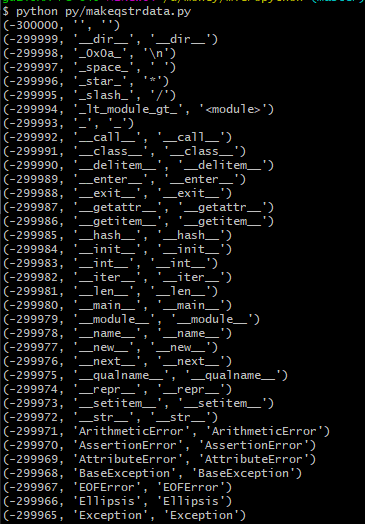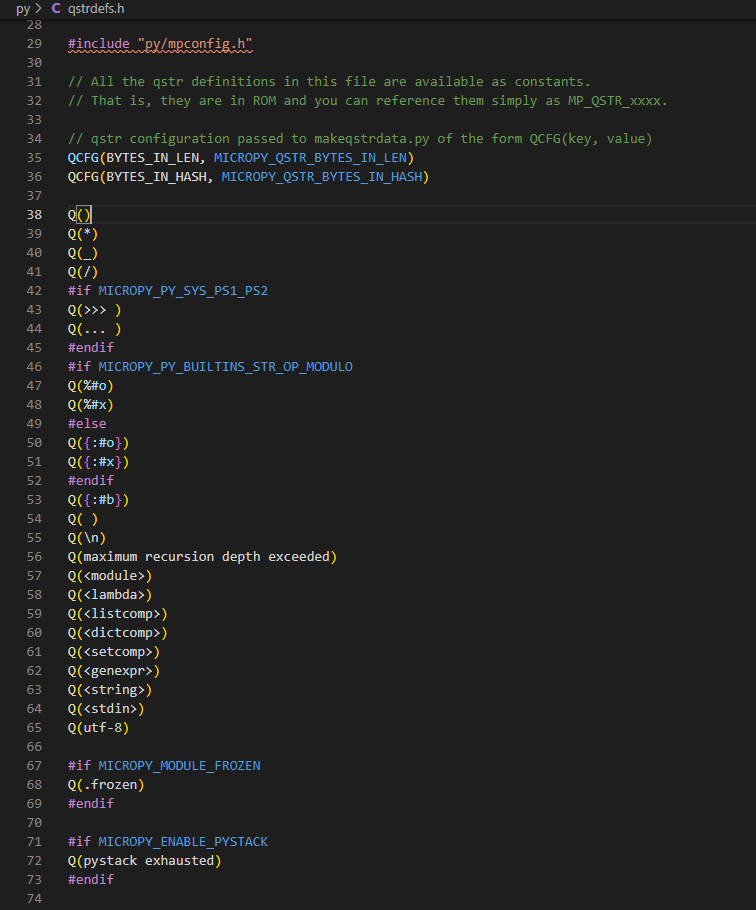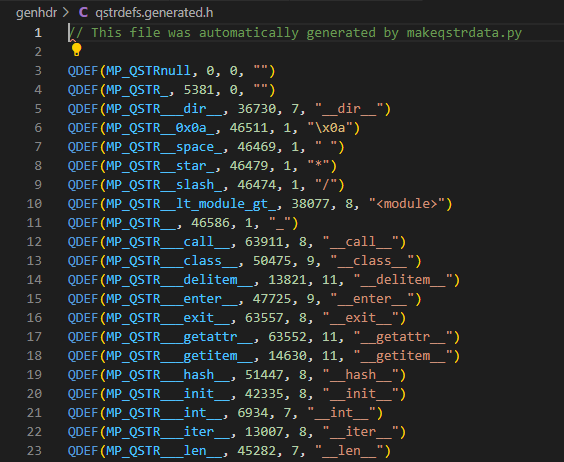- 转义非字母数字的字符,转义结果为预定义字符串codepoint2name[]
def qstr_escape(qst):
def esc_char(m):
c = ord(m.group(0))
try:
name = codepoint2name[c]
except KeyError:
name = "0x%02x" % c
return "_" + name + "_"
return re.sub(r"[^A-Za-z0-9_]", esc_char, qst)- 生成静态qstr列表
def parse_input_headers(infiles):
qcfgs = {}
qstrs = {}
# add static qstrs
for qstr in static_qstr_list:
# work out the corresponding qstr name
ident = qstr_escape(qstr)
# don't add duplicates
assert ident not in qstrs
# add the qstr to the list, with order number to retain original order in file
order = len(qstrs) - 300000
qstrs[ident] = (order, ident, qstr)
print(qstrs[ident])执行结果

- 生成输入文件的qstr列表,带去重机制
# 主要做两件事:提取QCFG配置的长度字节数和哈希字节数,提取Q描述的qstr字符串
# read the qstrs in from the input files
for infile in infiles:
with open(infile, "rt") as f:
for line in f:
line = line.strip()
# is this a config line?
match = re.match(r"^QCFG\((.+), (.+)\)", line)
if match:
value = match.group(2)
if value[0] == "(" and value[-1] == ")":
# strip parenthesis from config value
value = value[1:-1]
qcfgs[match.group(1)] = value
continue
# is this a QSTR line?
match = re.match(r"^Q\((.*)\)$", line)
if not match:
continue
# get the qstr value
qstr = match.group(1)
# special cases to specify control characters
if qstr == "\\n":
qstr = "\n"
elif qstr == "\\r\\n":
qstr = "\r\n"
# work out the corresponding qstr name
ident = qstr_escape(qstr)
# don't add duplicates
if ident in qstrs:
continue
# add the qstr to the list, with order number to retain original order in file
order = len(qstrs)
# but put special method names like __add__ at the top of list, so
# that their id's fit into a byte
if ident == "":
# Sort empty qstr above all still
order = -200000
elif ident == "__dir__":
# Put __dir__ after empty qstr for builtin dir() to work
order = -190000
elif ident.startswith("__"):
order -= 100000
qstrs[ident] = (order, ident, qstr)- 生成QSTR表的输入文件示例,即Q(string)

- 将生成的QSTR表定位到文件

上述问题解决:输入 bash 回车,然后再次执行生成


- 修改脚本使输出格式符合代码运行要求
def make_bytes(cfg_bytes_len, cfg_bytes_hash, qstr):
qbytes = bytes_cons(qstr, "utf8")
qlen = len(qbytes)
qhash = compute_hash(qbytes, cfg_bytes_hash)
if qlen >= (1 << (8 * cfg_bytes_len)):
print("qstr is too long:", qstr)
assert False
qdata = escape_bytes(qstr, qbytes)
# return '%d, %d, "%s"' % (qhash, qlen, qdata)
return '(const byte*)"\\x%02x\\x%02x\\x%02x" "%s"' % (qhash >> 8, qhash & 0xFF, qlen, qdata)
def print_qstr_data(qcfgs, qstrs):
# get config variables
cfg_bytes_len = int(qcfgs["BYTES_IN_LEN"])
cfg_bytes_hash = int(qcfgs["BYTES_IN_HASH"])
# print out the starter of the generated C header file
print("// This file was automatically generated by makeqstrdata.py")
print("")
# add NULL qstr with no hash or data
# print('QDEF(MP_QSTRnull, 0, 0, "")')
print('QDEF(MP_QSTRnull, (const byte*)"\\x00\\x00\\x00" "")')
# go through each qstr and print it out
# sorted(object, key=lambda 变量:变量[维数] ):对qstrs按第一维数据进行由小到大排序
for order, ident, qstr in sorted(qstrs.values(), key=lambda x: x[0]):
qbytes = make_bytes(cfg_bytes_len, cfg_bytes_hash, qstr)
print("QDEF(MP_QSTR_%s, %s)" % (ident, qbytes))